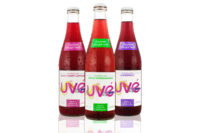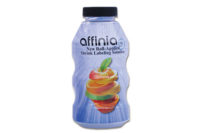Whether it’s reported in the news media, discussed by the office water cooler or written about in blogs, consumers are at no loss for information about the obesity crisis that is affecting the United States. The Center for Disease Control and Prevention (CDC), Atlanta, estimates that more than one-third of Americans are obese.
As organizations work to inform consumers about ways to combat obesity, beverage manufacturers also are doing their part to make healthful choices easier by offering more functional products.
“The functional beverage market in general is expanding out from traditional products such as sports nutrition shakes and energy drinks,” says Yuchu Zhang, director of innovation with Glanbia Nutritionals North America Inc., Carlsbad, Calif. “Combined with consumers’ shift away from supplements toward functional foods and beverages, this leaves a wide market for weight management-positioned beverages.”
Zhang adds that functional waters, juices, teas and smoothies all have the potential to be fortified with weight management ingredients.
Reaching consumers
As consumers become more educated about weight management, consumer packaged goods (CPG) companies are challenged with taking that extra step with consumers.
“Unlike in the past, when consumers were focused solely on simple weight loss, current consumers are looking for more specific claims for beverages with weight management ingredients in the weight loss marketplace,” Zhang says.
She suggests that product claims hone in on consumers’ wants and needs, such as the following: controlling hunger and boosting satiety; increasing metabolism and promoting thermogenesis; burning fat and blocking or limiting fat storage in the body; and swapping fat mass for lean muscle mass.
Paul Dijkstra, chief executive officer of InterHealth Nutraceuticals, Benicia, Calif., notes the importance of formulating with ingredients for satiety, or a feeling of fullness.
“Satiety is a benefit [that] consumers can feel right away — it’s tangible,” he says.
Dijkstra adds that it is important for those claims to be supported by well-documented research.
“Product claims should be backed by well-designed clinical studies so as not to mislead consumers of any expected benefits,” he says. “Consumers demand and deserve both efficacious and safe products that supply well-researched ingredients that can substantiate meaningful product claims.”
Packed with fiber
In order to provide efficacious products that support weight management claims, beverage manufacturers can turn to a number of ingredients. Among the most well-known ingredients is fiber, both soluble and insoluble.
Key components of providing a product that has a satiety claim include the inclusion of fiber and protein, says Käti Ledbetter, product development scientist with Archer Daniels Midland Co. (ADM), Decatur, Ill. Under its Fibersol line, ADM in partnership with Japanese company Matsutani offer a range of dietary fibers, including Fibersol-2 digestion-resistant maltodextrin, a soluble corn fiber that acts as a low-calorie bulking agent and contains 90 percent dietary fiber, Ledbetter says. Also available for beverage application is
Fibersol-LQ corn syrup, which contains approximately 75 percent fiber on a dry solid basis, she adds.
“Fibersol-LQ has been specially designed for applications where added sweetness and humectancy are beneficial as well as facilitating the ease of handling of a liquid product,” Ledbetter says. “Both of these ingredients found in the Fibersol line of dietary fibers are key ingredients used to incorporate fiber into beverages positioned for weight management.”
Citing clinical studies, Ledbetter says Fibersol-2 has been shown to help relieve occasional constipation and, in select studies, showcased an improvement in stool consistency. Recent studies also support the fiber line’s increased feeling of satiety.
Adding more flexibility in applications, Minneapolis-based Cargill announced earlier this year that its natural soluble fiber Oliggo-Fiber inulin now is available as a fiber syrup in addition to the free-flowing powder form originally available for food and beverage manufacturers.
Made from chicory roots, Oliggo-Fiber inulin is virtually an invisible liquid soluble fiber and is an option for reducing fat and calorie content in products, such as those targeted at weight management, because it can act as a fat and carbohydrate replacer while maintaining desired texture, the company says.
“Studies have shown that consuming fiber may help maintain a feeling of fullness, and research also demonstrates that inulin may enhance calcium absorption among pre-teens and post-menopausal women, making it important for bone health,” said Deborah Schulz, product manager with Cargill Health & Nutrition, in a statement. “Oliggo-Fiber inulin also is a prebiotic that helps maintain healthy digestive balance by supporting the growth of normal, beneficial bacteria in the lower gastro-intestinal tract. It is suitable for use in diabetic or low-glycemic diets as well.”
Although unable to be incorporated in a large variety of beverage categories, insoluble fiber also can be a popular ingredient for products such as smoothies, meal replacement drinks and milkshakes.
“Your body needs a balance of soluble and insoluble fiber, so there’s really a place for both of those in the nutritional profile,” says Flint Williams, vice president of sales and marketing with Fibred-Maryland Inc., LaVale, Md.
Offering multiple benefits, Williams says insoluble soy fiber can replace ingredients such as whey and gluten as well as offer other value-added capabilities.
“It also will absorb fat and it does that in your body as well as in the product, so through that you can get a calorie reduction [and] you can get the fiber nutritional benefit [of] all the things that fiber brings to your diet,” he says.
Because insoluble fiber will not dissolve in liquid, Williams says the ingredient is limited to high-viscosity drinks, but its neutral taste and colorless application make it an easy-to-incorporate ingredient for beverages that have properties with which the fiber can bond.
Fibred-Maryland also is investing in its research and development department to explore different fibers that could offer multiple benefits.
“We’re looking at some blends of fiber that have lower calories and lower fat content [to] take the place of some less desirable ingredients that are found in some things,” Williams says. “Those are things that are on the horizon.”
Expanding opportunities
Also offering satiety benefits are staple ingredients such as soy, casein and whey proteins. Glanbia’s sister company GNIT offers whey protein for beverage applications. Glanbia’s Zhang highlights a researched benefit of using whey protein ingredients.
“Energy expenditure and thermogenic effect were greater with the protein-rich meals than the high-carbohydrate meal, and the effects of whey, including fat oxidation, were significantly greater than those of casein and soy,” she says.
At the Institute of Food Technologists (IFT) Food Expo, ADM unveiled the newest product in its Clarisoy line — Clarisoy 150. Clarisoy 150 is a soy protein for use in low-pH beverages with cloud systems and neutral-pH beverages, the company says. Last year at the IFT event, ADM introduced Clarisoy 100, a 100 percent soluble isolated soy protein for beverage applications with a pH below 4.0.
Beyond proteins and fibers, weight management ingredient options are expanding past the well-known staples.
“Some of the newer [ingredients] that are being used in weight management would [be] some botanical ingredients like guarana, yerba mate [and] even black pepper extract,” says Cathy Arnold, senior formulation scientist supervisor with Fortitech, Schenectady, N.Y.
Offering custom blend pre-mixes, other ingredients that Fortitech has incorporated into weight management formulations include caffeine, green tea, chromium, B vitamins and selenium, Arnold says.
Ingredients such as guarana and conjugated linoleic acid (CLA) are some options that also can help with fat burning. “Hopefully you can keep them at levels [where] there’s been research on them,” she says. “To keep them at effective levels, you really need to include that in the beverage … at a level that is workable.”
In addition to B vitamins, calcium as well as vitamins A, C and E can help maintain energy levels and a sense of well-being, says Glanbia’s Zhang. Antioxidants such as glutathione and L-Carnitine also help to promote a healthy response to inflammation that takes place during and after workouts, she adds.
InterHealth also is turning to ingredients outside of traditional fiber and protein offerings for weight management formulations. Containing hydroxycitric acid (HCA), an extract from the South Asian Garcinia cambogia fruit that is bound to the minerals calcium and potassium, InterHealth offers its Super CitriMax.
“Published peer-reviewed clinical research demonstrates that Super CitriMax increases weight loss partly because of its ability to increase satiety and reduce calorie intake,” Dijkstra says. “A randomized placebo-controlled study showed that Super CitriMax taken in beverages for two weeks significantly decreased daily [calorie] intake by 25 percent and calories from snacking by 40 percent compared to placebo, leading to reduced body weight.”
Also supporting healthy body weight claims, InterHealth’s ChromeMate is a highly bioavailable chromium. The ingredient supports balanced sugar levels to help assist with appetite control and reduced food cravings, Dijkstra says.
“Randomized, double-blind, placebo-controlled research shows that ChromeMate increases fat loss and maintains lean body mass,” he says.
The two weight management ingredients also have achieved generally recognized as safe status by an independent toxicology group. Both highly soluble, Super CitriMax and ChromeMate are virtually tasteless, odorless and colorless, which makes them a logical fit for a number of beverage products, including water, ready-to-drink beverages, fruit juices, dairy beverages, drinkable yogurt and sachets, Dijkstra explains. The ingredients also are heat-stable and suitable for hot-fill, cold-fill, ultra-high temperature and retort processing, he adds.
Formulating for success
With so many ingredients offering weight management benefits, beverage-makers must ensure the ingredients work well together.
“Ingredient interaction is common,” Glanbia’s Zhang says. “It can be minimized by either limiting reactive nutrients to separate pre-mixes or encapsulating more reactive ingredients. Some nutrient losses in processing and storage can be overcome by adding overages.”
Another important aspect of the development process for many ingredients is protecting them from the elements and additional outside factors that could affect their efficacy.
“To protect fatty acid ingredients, we minimize their exposure to oxygen, heat, light and transition metals during the manufacturing process and during product handling and storage,” Zhang says. “We also use antioxidants, microencapsulation technology and low-temperature storage.”
Zhang also notes the importance of keeping proteins, such as whey protein, properly hydrated in order to maintain heat stability.
Fortitech’s Arnold says formulations also can use agglomeration to make a small particle size larger and more soluble in liquid. Screening and milling also could offer the opposite result by reducing the particle size, resulting in all the particles fitting within one solution properly, she says.
Weigh-less future
As more beverage categories expand into weight management product offerings, the industry will continue to see innovation and documentation to support that innovation, experts predict.
In reference to botanicals and additional ingredients associated with medicinal purposes, Fortitech’s Arnold anticipates more research to be conducted on these ingredients and their impact on weight management.
Proteins and fibers also will offer more opportunities as formulators are finding ways to incorporate weight management into a range of products.
“The weight management beverage category continues to expand beyond traditional meal replacement beverages,” ADM’s Ledbetter says. “The push for lowering sugars [and] increasing fiber and protein continue to be the main pushes in beverages designed for weight management. Fruit- and vegetable-based juices are expected to experience double-digit growth over the next few years. With this continued trend, beverage brand owners will continue to focus on ways to incorporate fiber and protein in low-pH or juice-based drinks.” BI






